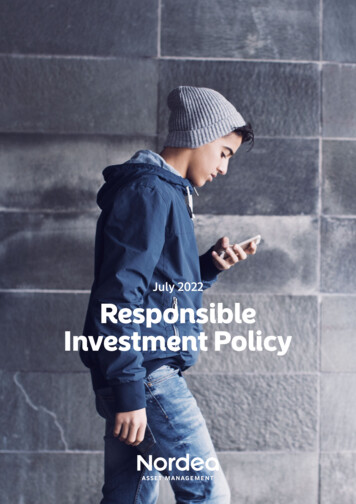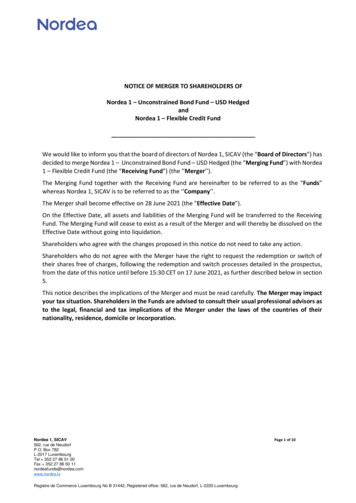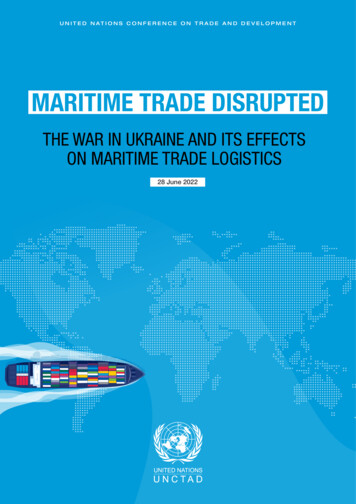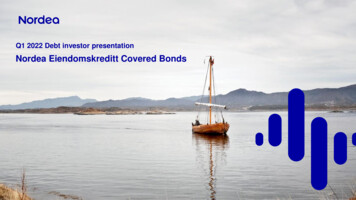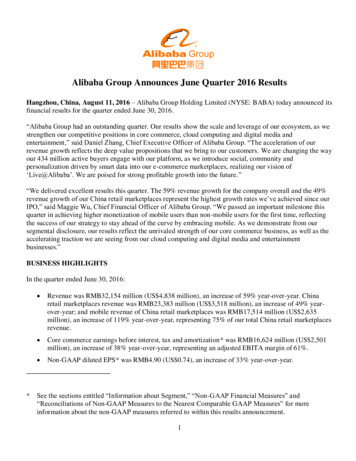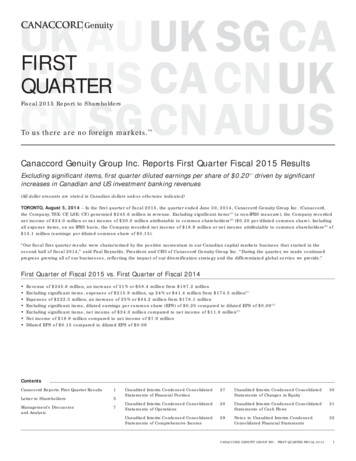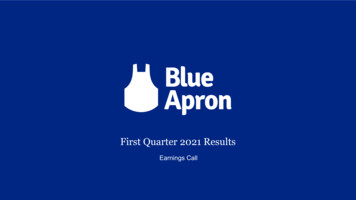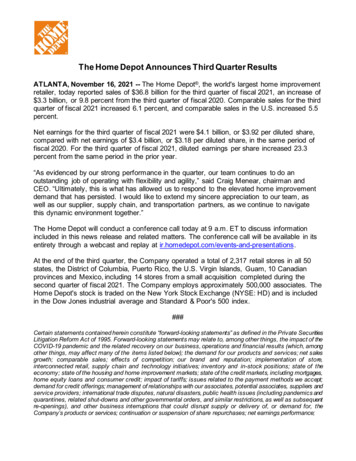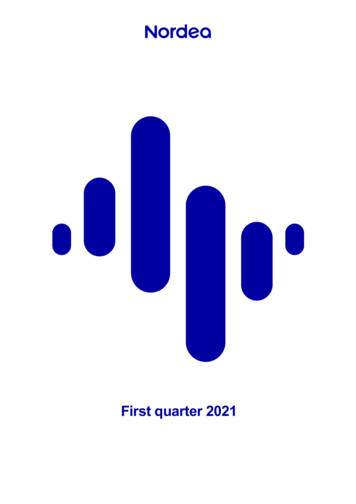
Transcription
First quarter 2021Confidential
NordeaQ1First quarter 2021First-quarter results 2021Summary of the quarter: Continued growth in business volumes and customersatisfaction across Nordics. Mortgage volumes grewby 6% in local currencies, year on year, and lending tosmall and medium-sized enterprises increased by 7%.Assets under management increased by 33% to EUR372bn, driven by market recovery and continued netinflows, especially into retail funds. Customer satisfactionscores continue to increase. Strong result, driven by high income growth.Operating profit increased by 75%, year on year, mainlydriven by significantly higher total operating income,which increased by 21%. Net interest income increasedby 9%, net fee and commission income increased by 8%and net fair value result was exceptionally high due tostrong financial market activity. Cost development in line with plan. Increasedresolution fees and exchange rate effects resulted inhigher costs in the first quarter. Adjusted for those items,and the inclusion of Nordea Finance Equipment (NFE),total costs were down 3%, year on year. In 2021 the fullexpected resolution fee for the year (EUR 224m) wasbooked in the first quarter, whereas in 2020 the resolutionfee had been booked in two instalments – EUR 153m inthe first quarter and EUR 49m in the second. Staff costswere down 2%, even after including the costs from NFE.The full-year 2021 cost outlook is below EUR 4.6bn. Strong credit quality with low realised net loanlosses. Net loan losses and similar net result amountedto EUR 52m or 6bp, compared with EUR 155m or 19bp inthe first quarter of 2020. Realised net loan losses werelow. The management judgement buffer was maintainedat EUR 650m, as the full impact of the COVID-19pandemic on Nordea’s customers remains uncertain. Profitability improving. Return on equity increased to11.0% from 6.9%, despite the very high equity basearising from undistributed dividends. Nordea's cost-toincome ratio with amortised resolution fees decreased to48% from 57%, supported by strong income growth andcontinued cost efficiency. Earnings per share increasedby 73% to EUR 0.19. Continued capital build – dividend plan confirmed.Nordea’s CET1 ratio was up 150bp to 17.5%, 7.3percentage points above the current regulatoryrequirement. The Annual General Meeting on 24 Marchauthorised the Board to decide on a dividend payment ofa maximum of EUR 0.72 (EUR 0.33 for 2019 and EUR0.39 for 2020), to be distributed after September 2021, inline with the European Central Bank’s guidance. On track to reach 2022 financial targets. Nordea isprogressing towards its financial targets: a cost-to-incomeratio of 50% and a return on equity above 10%. Nordeacontinues to focus on its three key priorities: to creategreat customer experiences, drive income growthinitiatives and optimise operational efficiency.(For further viewpoints, see the CEO comment on page 2. For definitions,see page 53).Group quarterly results and key ratios Q1 2021EURmNet interest incomeNet fee and commission incomeNet fair value resultOther incomeTotal operating incomeTotal operating expenses excluding resolution feesTotal operating expensesProfit before loan lossesNet loan losses and similar net resultOperating profitCost-to-income ratio with amortised resolution fees, %Return on equity with amortised resolution fees, %Diluted earnings per share, 11.00.19576.90.11Chg 7373578.40.18210646Chg %44719-1081086For further information:Matti Ahokas, Head of Investor Relations, 358 405 759 178Ulrika Romantschuk, Head of Brand, Communication and Marketing, 358 10 416 8023Frank Vang-Jensen, President and Group CEO, 358 503 821 391Ian Smith, Group CFO, 45 5547 8372Nordea is a leading Nordic universal bank. We are helping our customers realise their dreams and aspirations – and we have done that for 200 years. We wantto make a real difference for our customers and the communities where we operate – by being a strong and personal financial partner. The Nordea share islisted on the Nasdaq Helsinki, Nasdaq Copenhagen and Nasdaq Stockholm exchanges. Read more about us on nordea.com1
NordeaQ1First quarter 2021CEO comment“For society, the first few months of 2021 have been abalancing act between managing ongoing COVID-19restrictions and preparing exit strategies from the pandemic.At Nordea we are actively supporting and driving asustainable recovery together with our customers. We havereceived encouraging feedback for our efforts and customersatisfaction scores continue to increase.In Business Banking customer lending volumes grew by 7%,year on year. The growth accelerated towards the end of thequarter, with progress in Norway and Sweden in particular.Adjusted for resolution fees, costs increased by 3% due to theinclusion of NFE. I am very glad to see an improvement incustomer satisfaction – particularly in Sweden, where,according to the Prospera rankings, we climbed from fifth tofirst place for personal contact and ranked second overall.Our performance improved on the back of high levels ofbusiness and customer activity, and results in the quarterwere strong. We continued to achieve good growth inbusiness volumes across the Nordic region. Mortgagevolumes grew by 6%, year on year, and lending to small andmedium-sized enterprises increased by 7%. Assets undermanagement (AuM) increased by 33% to EUR 372bn. Thegrowth in AuM was supported not only by positive financialmarket development but also by a quarterly net inflow of EUR3.3bn, over half of which was into retail funds.We continue to reposition Large Corporates & Institutions witha view to achieving a more focused and profitable businessarea. We saw very high levels of customer activity across ourfocus segments, especially in our capital markets business. Inaddition, our Markets income was very strong during thequarter. The first quarter of 2021 was the third quarter in arow with a return on capital at risk above 10%.In Asset & Wealth Management AuM increased by 33%, yearon year, to an all-time high of EUR 372bn. It was especiallypleasing to see increased momentum in retail fund netinflows, which totalled EUR 1.7bn in the quarter. We saw highlevels of interest in our sustainability products, and customersatisfaction remained high.Our operating profit increased by 75%, year on year, mainlydriven by a 21% increase in total operating income. Netinterest income grew by 9%, which is the highest growth ratein ten years. Net fee and commission income grew by 8% andwas at its highest level since 2017. Net income from lendingand savings fees increased, while net income from card feeswas still about one-third below normal levels. Exceptionallystrong financial market activity and valuation gains supportedour net fair value result during the quarter.By the end of the quarter our Group CET1 ratio had increasedby 150bp to 17.5%, making us one of the best capitalisedbanks in Europe. We have a buffer of 7.3 percentage pointsabove the current regulatory requirement, even after havingdeducted both the 2019 and 2020 dividends and the 2021dividend accrued thus far.We continued to work on our cost base and improveefficiency, while also driving income growth initiatives. Costsin the first quarter were elevated due to increased resolutionfees and exchange rate effects. However, excluding theseitems, costs were lower than a year ago. Staff costs weredown 2%, even after including the costs from Nordea FinanceEquipment (NFE). We are focused on meeting our full-yeartarget for costs to be below EUR 4.6bn, even though that isbecoming more demanding due to high levels of businessactivity and strengthening exchange rates. Overall, exchangerates had a positive impact on results.Our capital position enables us to both support our customersand pay out dividends to our shareholders. Our dividend planis clear and was confirmed by the Annual General Meeting(AGM) on 24 March. The AGM authorised the Board to decideon a dividend payment of a maximum of EUR 0.72, to bedistributed after September 2021, in line with the EuropeanCentral Bank’s guidance.In addition, our AGM approved the proposal for increasedshare buy-backs. As communicated earlier, share buy-backsare an important tool to distribute excess capital to ourshareholders. We plan to implement buy-backs after thecurrent restrictions are repealed.Our credit quality remained strong in the first quarter.Realised loan losses have been very low and net loan lossesfor the quarter were EUR 52m. However, we have kept ourmanagement judgement buffer unchanged at EUR 650m, asthe full impact of the COVID-19 pandemic on Nordea’scustomers remains uncertain.We have now been executing our business plan for a yearand a half, and are well on track to meet our financial targetsfor 2022. We are determined to continuously improve ourperformance by focusing on our three key priorities: to creategreat customer experiences, drive income growth initiativesand optimise operational efficiency. We will also continue tointegrate sustainability into our business strategy and take thenecessary steps to become a net-zero emissions bank by2050 at the latest.A combination of exceptionally strong revenue growth andcontinuous cost discipline drove our cost-to-income ratiodown to 48%, compared with 57% a year ago. Return onequity increased to 11.0% from 6.9%, despite the negativeimpact of the high equity base.All business areas remain focused on delivering on theirtargets. In Personal Banking mortgage lending volumes grewby 6%, year on year – the highest growth rate since 2016.Positive net fund inflows continued and savings income grewby 6%. Adjusted for resolution fees, costs increased by 1%,and the cost-to-income ratio improved to 52%. Customersatisfaction continued to increase.I am confident that we are moving towards brighter times andsteadily beating the virus. Nordea will enter the postpandemic future in a position of strength. Our direction isclear: to be a strong and personal financial partner, a moreprofitable bank, and a safe and trusted contributor to society.”Frank Vang-JensenPresident and Group CEO2
NordeaFirst quarter 2021Q1OutlookKey priorities to meet 2022 financial targetsCapital policyNordea’s business plan focuses on three key priorities tomeet its 2022 financial targets: 1) to optimise operationalefficiency, 2) to drive income growth initiatives, and 3) tocreate great customer experiences.A management buffer of 150-200bp above the regulatoryCET1 requirement, from 1 January 2021.Financial targets for 2022Nordea’s dividend policy stipulates a dividend payout ratio of60-70%, applicable to profit generated from 1 January 2021.Nordea will continuously assess the opportunity to use sharebuy-backs as a tool to distribute excess capital.Dividend policyNordea’s financial targets for 2022 are: a return on equity above 10% a cost-to-income ratio of 50%Costs (operating expenses)Total costs for 2021 are expected to be below EUR 4.6bn.3
NordeaFirst quarter 2021Table of contentsIncome statement .5Macroeconomy and financial markets .6Group results and performanceFirst quarter 2021. 7Net interest income. 7Net fee and commission income .8Net result from items at fair value .9Total operating income . 9Total expenses . 10Net loan losses and similar net result .11Credit portfolio . 13Profit. 13Capital position and risk exposure amount .13Regulatory developments .15Balance sheet. 15Funding and liquidity operations .15Market risk . 15Other information. 16Quarterly development, Group.17Business areasFinancial overview by business area.18Personal Banking. 19Business Banking. 22Large Corporates & Institutions . 25Asset & Wealth Management. 27Group Functions . 31Financial statementsNordea Group. 32Notes to the financial statements. 36Nordea Bank Abp. 544Q1
NordeaQ1First quarter 2021Income statementQ12021Q12020Chg %Localcurr. %Q42020Chg %Localcurr. 151-1,319-130-1,248166154-177-1,218-158-167EURmNet interest incomeNet fee and commission incomeNet result from items at fair valueProfit from associated undertakings and jointventures accounted for under the equity methodOther operating incomeTotal operating incomeStaff costsOther expensesDepreciation, amortisation and impairmentcharges of tangible and intangible assetsTotal operating expensesProfit before loan losses1,10175446441,001108Net loan losses and similar net resultOperating -13946088718568-2487255947Localcurr. %31 Dec2020Chg %Localcurr. come tax expenseNet profit for the periodBusiness volumes, key items131 Mar202131 Mar2020Chg 25.8EURbnLoans to the publicLoans to the public, excluding reposDeposits and borrowings from the publicDeposits from the public, excluding reposTotal assetsAssets under managementEquityRatios and key figures2Chg %736864900Diluted earnings per share (DEPS), EUREPS, rolling 12 months up to period end, EURShare price1, EUREquity per share1, EURPotential shares outstanding1, millionWeighted average number of diluted shares, millionReturn on equity, %Return on tangible equity, %Return on risk exposure amount, %Return on equity with amortised resolution fees, %Cost-to-income ratio, %Cost-to-income ratio with amortised resolution fees, %Net loan loss ratio, incl. loans held at fair value, bpCommon Equity Tier 1 capital ratio1,3, %Tier 1 capital ratio1,3, %Total capital ratio1,3, %Tier 1 capital1,3, EURbnRisk exposure amount1, EURbnReturn on capital at risk, %Return on capital at risk with amortised resolution fees, %Number of employees (FTEs)1Economic capital1, EURbn1 End of period.2 For more detailed information regarding ratios and key figures defined as alternative performance measures,see ts-and-presentations/group-interim-reports.3 Including the result for the 5Chg %616262002-1-1-11187
NordeaQ1First quarter 2021Macroeconomy and financial markets1Economic outlookNorwayThe global economy slowed during the fourth quarter of 2020,as new containment measures were introduced in manycountries amid the second and third waves of the COVID-19pandemic. Economic policies remained accommodative. Thenew US administration implemented a large stimuluspackage, which, in combination with the roll-out of globalvaccine programmes and sharply rising commodity prices, ledto increasing inflation expectations and higher interest rates.Equity markets continued to perform strongly.Norwegian mainland GDP grew by 1.8%, quarter on quarter,in the fourth quarter of 2020. In 2020 as a whole, thecountry’s GDP decreased by 2.5%. Amid the introduction ofstricter containment measures in the first quarter of 2021,unemployment increased slightly, and stood at 4.2% inMarch. COVID-19 restrictions continued to weigh on growth.Infection rates rose during the first quarter, but the overallsituation has remained under control. House prices continuedto rise and were 12.5% higher in March 2021 than in thesame month last year. Norges Bank has stated that the firstrate hike will come either during September or December2021 – we expect that it will be in September. The Norwegiankrone strengthened significantly during the first quarter due toa higher oil price and signals of early rate hikes from thecentral bank.The recovery of the global economy is expected to gainspeed during the second quarter of 2021 as more economiesreopen. Pre-COVID-19 global gross domestic product (GDP)levels are expected to be reached by the end of the year.The Nordic countries have been among the best performingcountries globally during the pandemic. However, they allexperienced a relatively weak end to 2020 due to newcontainment measures, which lasted into the first quarter of2021. The recovery is expected to gain speed in the Nordicsduring the second quarter.SwedenSwedish GDP edged down by 0.2%, quarter on quarter, in thefourth quarter of 2020. In 2020 as a whole, the country’s GDPdecreased by 2.8%. Exports continued to perform well in thefourth quarter, while domestic demand decreased. AlthoughCOVID-19 infection rates rose again during the first quarter of2021, the initial positive effects of the vaccine roll-out alsostarted to emerge. Indicators suggest that GDP growth wasresilient in the first quarter despite new restrictions related tothe virus. The situation in the labour market improved, withthe unemployment rate falling to 8.4% in March. House pricesincreased markedly and were 20.3% higher in March 2021than in the same month last year. Sveriges Riksbank kept itsrepo rate unchanged at 0.0% and signalled that it wouldremain unchanged for the coming three years. Thequantitative easing programme was kept unchanged and willcover the remainder of 2021. The trade-weighted Swedishkrona weakened by 3% in the course of the first quarter.DenmarkDanish GDP increased by 0.7%, quarter on quarter, in thefourth quarter of 2020. In 2020 as a whole, the country’s GDPdecreased by 2.7%. Exports fell marginally after a strongrebound in the third quarter, while private consumptionincreased strongly due to the payout of frozen holiday pay inOctober. A sharp increase in the number of COVID-19 casesin the late autumn of 2020 led to new, harsh containmentmeasures. These in turn led to an increase in theunemployment rate, which stood at 4.6% at the end ofFebruary 2021. However, a gradual reopening of the Danisheconomy began on 1 March. House prices have increasedsharply over the past 12 months and were 12.3% higher inMarch 2021 than in the same month last year. The Danishkrone has appreciated against the euro since the independentinterest rate hike in March 2020. This caused DanmarksNationalbank to intervene in the foreign exchange market inFebruary and March.FinlandFinnish GDP grew by 0.4%, quarter on quarter, in the fourthquarter of 2020. In 2020 as a whole, the country’s GDPdecreased by 2.8%. Exports of goods and services grewrapidly in the fourth quarter, while private consumptionremained almost unchanged. In March 2021 the COVID-19situation deteriorated somewhat, slowing down the recoveryin private consumption. The unemployment rate stood at8.1% in February and employment remained at similar levelsto those of last year. House prices increased by 1.2%, yearon year, in February. Prices increased by 3.4% in GreaterHelsinki and declined by 0.9% in the rest of the country. Whilebuilding permits and starts increased, construction activity asa whole continued to decline.1Source:6Nordea Economic Research
NordeaQ1First quarter 2021Group results and performanceFirst quarter 2021Net interest incomeQ1/Q4: Loans to the public excluding repurchase agreementswere up 1% in local currencies. Lending volumes increased inlocal currencies in Personal Banking and Business Banking,but decreased as planned in Large Corporates & Institutions.Q1/Q1: Net interest income increased by 9%. The maindrivers were increased SME and mortgage lending volumes,and margins, which included the benefit of EUR 28m infunding from the European Central Bank under the thirdtargeted longer-term refinancing operations programme(TLTRO III). Nordea Finance Equipment (NFE) contributedpositively to net interest income, as did exchange rate effects,which had a positive impact of approximately EUR 31m.Deposit volumesQ1/Q1: Total deposits from the public excluding repurchaseagreements were up 10% in local currencies. Depositvolumes increased in local currencies in Personal Banking,Business Banking and Large Corporates & Institutions.Q1/Q4: Net interest income increased by 4% to EUR 1,212m,mainly driven by margins, which included the EUR 28mTLTRO benefit. This was partly offset by the negative impactof a lower day count.Q1/Q4: Total deposits from the public excluding repurchaseagreements were up 7% in local currencies. Deposit volumesincreased in local currencies in Personal Banking, BusinessBanking and Large Corporates & Institutions.Lending volumesQ1/Q1: Loans to the public excluding repurchase agreementswere up 3% in local currencies. Lending volumes increased inlocal currencies in Personal Banking and Business Banking,but decreased as planned in Large Corporates & Institutions.Net interest income per business areaEURmPersonal BankingBusiness BankingLarge Corporates & InstitutionsAsset & Wealth ManagementGroup FunctionsTotal 12221,1097124-13603340-7-12111,21231Change in net interest income (NII)EURmNII beginning of periodMargin-driven NIILending marginDeposit marginCost of fundsVolume-driven NIILending volumeDeposit volumeDay countOther1NII end of period1 of which FXLocal currencyQ1/Q1Q1/Q4Q1217
NordeaQ1First quarter 2021Net fee and commission incomeQ1/Q1: Net fee and commission income increased by 8%.The main drivers were growth in net income from savings andinvestments and an increase in lending-related net fee andcommission income. These were partly offset by lower cardrelated net fee and commission income.Q1/Q4: Net fee and commission income from savings andinvestments increased by 2% to EUR 563m, mainly driven bygrowth in AuM. End-of-period AuM increased by 5%, or EUR18bn, to EUR 372bn, with a net inflow of EUR 3.3bn duringthe quarter.Q1/Q4: Net fee and commission income increased by 4% toEUR 827m. The main drivers were growth in net income fromsavings and investments and an increase in lending-relatednet fee and commission income.Payments and cards and lending-related commissionsQ1/Q1: Net fee and commission income from payments andcards decreased by 7%, mainly due to lower card-relatedincome driven by COVID-19. Lending-related net fee andcommission income increased by 16%, mainly due to higherlevels of customer activity.Savings and investment commissionsQ1/Q1: Net fee and commission income from savings andinvestments increased by 12%, mainly driven by growth inassets under management (AuM) and higher levels ofcustomer activity in the brokerage and advisory business.Q1/Q4: Net fee and commission income from payments andcards increased by 5% to EUR 115m. Lending-related net feeand commission income increased by 4% to EUR 146m.Net fee and commission income per business areaLocal %3%3%8%4%6%3%EURmPersonal BankingBusiness BankingLarge Corporates & InstitutionsAsset & Wealth ManagementGroup FunctionsTotal GroupNet fee and commission income per categoryLocal currencyQ1/Q1Q1/Q4EURmSavings and investments, netPayments and cards, netLending-related, netOther commissions, netTotal GroupAssets under management (AuM), volumes and net flowEURbnNordic Retail fundsPrivate BankingInstitutional salesLife & PensionTotalQ121Q420Q320Q220Q120Net .677.0101.746.1280.41.71.6-1.01.03.38
NordeaQ1First quarter 2021Net result from items at fair valueQ1/Q1: Net result from items at fair value increased by 236%,driven by higher positive investment valuations in Treasuryand exceptionally strong trading income in Markets. In the firstquarter of 2020 negative valuation adjustments had impactedboth Treasury and Markets.Q1/Q4: Net result from items at fair value increased by 71%to EUR 370m, driven by exceptionally strong trading incomein Markets. Income in the customer businesses alsoimproved.Net result from items at fair value per business 926-75110-6%-1%-32%9%EURmPersonal BankingBusiness BankingLarge Corporates & InstitutionsAsset & Wealth Mgmt. excl. Life & PensionLife & PensionGroup FunctionsTotal GroupEquity method14%7%71%Other operating incomeQ1/Q1: Income from companies accounted for under theequity method was EUR -14m, down from EUR -2m, drivenby an impairment charge.Q1/Q1: Other operating income increased by EUR 5m to EUR25m.Q1/Q4: Other operating income decreased by EUR 11m toEUR 25m. The fourth quarter of 2020 had included the sale ofthe Group’s interest in Automatia, amounting to EUR 10m.Q1/Q4: Income from companies accounted for under theequity method was EUR -14m, down from EUR 5m, driven byan impairment charge.Total operating income per business areaLocal nal BankingBusiness BankingLarge Corporates & InstitutionsAsset & Wealth ManagementGroup FunctionsTotal Group9
NordeaQ1First quarter 2021Total operating expensesQ1/Q1: Total operating expenses were up 6% due to higherresolution fees and higher depreciation and amortisation.These were partly offset by lower staff costs. Adjusted forresolution fees, exchange rate effects and the integration ofNFE, total expenses were down 3%, year on year. Exchangerate effects had a negative impact of approximately EUR 20mon total operating expenses.Q1/Q4: Other expenses increased by 52% to EUR 486m dueto higher resolution fees. Adjusted for resolution fees, otherexpenses decreased by 18%. The fourth quarter of 2020 hadincluded higher IT costs and provisions for costs related to theNFE integration.Depreciation and amortisationQ1/Q1: Depreciation and amortisation increased by 16%,reflecting an increased run rate.Q1/Q4: Total operating expenses increased by 8% to EUR1,319m due to higher resolution fees. These were partly offsetby lower staff costs and other expenses. Adjusted forresolution fees, total expenses decreased by 10%, quarter onquarter.Q1/Q4: Depreciation decreased by 15% to EUR 151m, as thefourth quarter of 2020 had included additional IT impairments
Strong credit quality with low realised net loan losses. Net loan losses and similar net result amounted to EUR 52m or 6bp, compared with EUR 155m or 19bp in the first quarter of 2020. Realised net loan losses were low. The management judgement buffer was maintained at EUR 650m, as the full impact of the COVID-19
